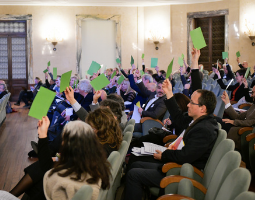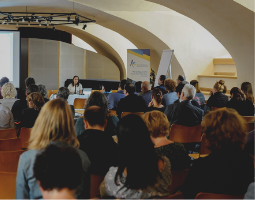Regulations
Erasmus+ provides the following opportunities for teaching and non-teaching staff employed in a higher education institution:
• teaching visits to partner institutions (workshops, master classes, examining visits etc.)
• training visits (job shadowing, continuous professional development activities)
The minimum length of staff mobility for teaching and/or training is 2 days; maximum length is 6 weeks (travel days excluded). In all cases, a teaching activity has to comprise minimum 8 hours of teaching per week (or any shorter period of stay).
Before the Mobility
Step 1
Call for applications/selection
The IRC of the home institution can organise an annual information event and/or send out an email to the intranet/internal mailing list with information of mobility possibilities and asking those interested in exchange to contact the international relations office. An internal deadline is advisable. Teachers can also be appointed/invited by management based on strategic consideration (continuous professional development, international recruitment etc.).
Step 2
Grant application submitted to the National Agency
The grant application needs to be submitted by the yearly call for proposals to the National Agency (NA) of the country of the applicant organisation. The application period usually takes place in March. Please follow the information given by your NA concerning the annual call for proposals.
Step 3
Internal application for teacher exchange
Staff members are selected by the sending institution. The minimum requirement (for teaching activities) is the level of knowledge of foreign language indicated in the inter-institutional agreement (IIA).
Each sending institution or department can set its own selection procedures and criteria. To offer equal opportunities for teachers and staff, it is advisable to announce a call for applications in the institution at least once a year. Although filling in specific application forms is not required, an internal application form can be helpful when collecting the staff visit proposals and plans.
Step 4
Internal decision on selection results
Some institutions might want to give priority to certain strategic areas. For example, exchanges comprising additional value e.g. project preparation, lectures integrated into the regular study programme of the receiving institution, preparation of new study material can be prioritized.
It is recommended to widen the scope of the exchange possibility to as many staff members as possible, therefore first time exchanges should be encouraged and supported.
Additional activities such as performance activities (concerts), lectures on specific topic(s), research activities, etc. should be agreed by both sending and receiving institutions in advance.
Step 5
Agreement between home and host institution
There are two ways of making an agreement for staff exchange. Either the initiative comes from the host institution who invites a staff member or from the sending institution potentially after the internal selection procedure. Note that the internal selection does not by itself guarantee that the mobility will take place! The receiving institution must have agreed on the duration of the visit and activities to be undertaken by the visiting teacher or staff member before starting the official procedures. When mobility is approved by the host institution, an invitation letter or e-mail from the receiving institution will be sent.
Step 6
Mobility Agreement for teaching/training approved by the home and host institutions
The Mobility Agreement for teaching and training visits is the foundation of mobility. The documents need to be confirmed and approved by the member of staff, the sending and the receiving institution. This guarantees that the sending institution counts the Erasmus+ exchange period into the staff member’s working hours. In addition, a Grant Agreement should be signed between the teacher and the home institution:
Staff Mobility Agreement for Teaching
Staff Mobility Agreement for Training
Step 7
Payment of grants to staff members
The home institution distributes grants by signing an agreement between the outgoing staff member and the home institution.
Staff members are awarded Erasmus+ grant: a lump-sum to help cover the mobility costs including travel and subsistence costs incurred in connection with teaching/training period abroad. National Agencies will give instructions for calculating the Erasmus+ staff mobility grants for staff visits. Travel grants are calculated according to the travel distance (p.45), duration of stay (number of days including travel dates) and daily rate per country group (p.46). The total individual support for staff (subsistence cost) is defined by each National Agency and/or home institution and has to be published on their websites.
The full amount of the grant might be paid out to the staff members as a lump-sum or it might be used to cover the actual costs depending on national legislation or institutional policy.
The institutions are advised to budget additional funding for staff mobility as Erasmus+ grants are often not sufficient to cover the mobility costs.
Teaching hours should be included in the normal workload of the teacher. No extra salaries should be required in connection with the Erasmus+ mobility. This could pose a challenge to part time teachers, for whom special arrangements might need to be made.
Step 8
Language assessment
There are no formal language assessment criteria. However it is expected that the sending institution respects the obligation taken by signing the IIA where it is indicated what the working languages are and what level is required.
If the outgoing staff member needs to improve his/her language skills, the sending institution can offer language courses from Organisational Support (OS) funds.
After the Mobility
Step 9
Confirmation of teaching/training signed by the host institution
The confirmation certifies that the staff member has undertaken the teaching/training assignment under the Erasmus+ programme. It is a document confirming the arrival and departure dates and the scope of teaching/training and possible other activities (concert performances, participation in examinations etc.) in hours, and serves as a verification of the payment of the teaching or training grant.
Step 10
Report to ECAS – Mobility Tool
Mobility Tool is a web platform for collaboration, management and reporting of mobility projects under the Erasmus+ programme. The IRC is responsible for entering the mobility data and participant details into the system.
Mobility Tool automatically sends out requests for participant reporting after the end of the mobility period, as indicated in the “End date” field of the mobility details. The participants receive an invitation to filling the report on their mobility.
The participant report is in the form of a web-based questionnaire with single choice, multiple choice and matrix- type of questions.
Step 11
Evaluation
It is expected that host and home institutions will monitor the mobility and evaluate its quality. Success of every single activity is very important for further successful cooperation between the two institutions. It is expected that good practice and success stories will be disseminated at least at the home institution. Information can also be sent to the NA at their request.






